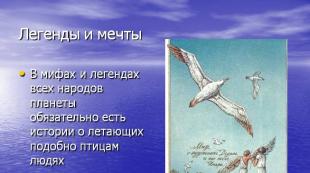The Golden Doe, Francis Drake's galleon. Sailboat "Golden Doe Golden hind" blueprints
"Golden Doe" ( Golden Hind, English) - small galleon the famous English pirate Francis Drake, the second ship in the history of navigation - after Ferdinand Magellan who has traveled around the world.
The sailboat left the stocks in the English city of Aldeburgh and was called "Pelican" ("Pelican", English). Like ship type "Pelican" was galleon, which came in the 16th century to replace and. galleons had a more slender body than karakki, without a massive aft superstructure. Like all galleons of that time, "Pelican" had three masts: mainsail, foresail and mizzen. The main and foremasts carried two tiers of straight sails, the mizzen mast was armed with a slanting "Latin" sail, under the bowsprit there was a direct sail - a blind.

Drawings for the construction of ships in those days were not yet known, so the size data "Pelican" vary: the length of the galleon varies in different sources from 20 to 40 meters, width - from 5.8 to 6.7 meters, displacement 100-150 tons. Regarding the armament of the sailboat, there is also no exact data, presumably "Pelican" was armed with 18-22 guns. The hull of the ship was decorated with yellow and red diamonds and the image of a pelican. After renaming the ship to "Golden Doe", instead of a pelican, an image of a fallow deer appeared on the body, and a completely golden figure of a fallow deer was installed under the bowsprit.

In December 1577, the most famous voyage began "Golden Doe"(then still "Pelican"). Royal privateer, favorite of Queen Elizabeth I, captain Francis Drake nicknamed the Iron Pirate led a squadron of five British ships from the port of Plymouth. These were the ships "Christopher", "Sea Gold", "Elizabeth", "Swan" and "Pelican". The squadron headed for the shores of South America in order to rob as many Spanish ships as possible.
In August-September 1578, the ships of the Dreykovskaya squadron passed Strait of Magellan(South America), but in the Pacific Ocean the ships got into a severe storm, in which they lost sight of each other. "Pelican" turned out to be alone. He was carried far to the south, due to which Francis Drake An important geographical discovery was made: Tierra del Fuego turned out to be not the top of an unknown southern continent, but just an archipelago. Discovered by the captain "Pelican" the strait was later named so - Drake Passage.

Loneliness did not stop Drake from plundering Spanish ships and harbors along the West Coast of South America, which he successfully did. The Spaniards had to equip an entire squadron to chase the elusive pirate. The hunt for Drake has begun. But after a long chase that lasted more than one day, "Pelican" managed to escape again. Inspired by luck, the captain decided to rename the ship to "Golden Doe" for its excellent sailing qualities. Another reason for the renaming of the vessel could be that a deer was depicted on the coat of arms of Drake's patron Lord Hutton. This was the first time that a ship's name was changed during the voyage. "Golden Doe" left the coast of South America across the Pacific Ocean past the island of Java and the Cape of Good Hope. And in September 1580 she returned to her native England, thus making the second round-the-world trip in world history. Drake's circumnavigation of the world turned out to be much more prosperous than the Magellanic expedition, most of whose sailors, and the famous captain himself, died during the trip. Francis Drake returned home not only safe and sound, but also brought 4700% of the profits from his trip, received as a result of three years of robbery and robbery. Most of the profits ended up in the British treasury, and Francis Drake was knighted personally by the queen Elizabeth I.

After this swim galleon "Golden Doe" became a universal object of admiration among the British. It was put into eternal parking on the Thames, where it stood for almost a hundred years until 1662, becoming one of the main attractions of London.
In the 20th century, two replicas of the legendary sailboat were created: in 1963 and 1973. They do not look alike, since the drawings "Golden Doe" was not, and the ship was restored according to scattered descriptions. The 1973 replica circled the world, repeating Drake's, and has stood on the south bank of the Thames since 1996 and serves as a floating museum. Second copy "Golden Doe" located in Brixham, Devonshire.
Drake's famous ship - the Golden Hind galleon
If you briefly characterize this person, then his fate is very unusual. In his youth, he became a ship captain, and later a successful sea pirate. Then he became a navigator and made the second circumnavigation of the world after Ferdinand Magellan. And after all this, he was promoted to admiral and defeated the invincible Spanish armada. We are talking about the legendary Francis Drake, an English navigator and vice admiral.
Admiral Francis Drake

Francis Drake was born in England in the village of Tavistock, Devonshire in the family of a farmer in 1540. From childhood, the boy dreamed of long-distance sea voyages and fame. Francis began the road to his dreams at the age of 13 by hiring as a cabin boy. The young man turned out to be a smart sailor and soon he became a senior assistant to the captain. Later, when Francis was 18 years old, he bought a small barque, on which he began to transport various cargoes. But ordinary sea transportation did not bring much wealth, which cannot be said about piracy and the slave trade. They gave more profit, and therefore, in 1567, Francis Drake, as a ship commander in the flotilla of his distant relative John Hawkins, set off on a long voyage to Africa for slaves and from there to the West Indies, where sailors traded in robbery and capture of Spanish ships. During this voyage, the young navigator gained vast experience in plundering and attacking merchant ships of the Spanish crown. Returning to England, they immediately started talking about him as a successful captain.
Soon, in November 1577, Francis Drake left the port of Plymouth on a ship and set off at the head of an expedition to the Pacific Ocean to the shores of America, the goal was to bring new lands under the English crown and also to seize Spanish ships and their valuable cargo. This time there were already five ships under Drake's command. Drake ship called "Pelican" was armed with 18 guns and had three masts. In terms of sailing armament, a hundred-ton ship belonged to a galleon. With a relatively small size, Drake's ship had good seaworthiness. Historians say that even Queen Elizabeth herself blessed these ships and presented memorable gifts.
The sea trip started well. By the end of January 1578, Drake's ships arrived on the coast of Morocco, where the British captured the city of Mogadar. Having received a large number of various valuable goods as a reward, sea pirates headed for the shores of America, where they engaged in robbery. During this, several of Drake's ships were in mutiny. Some sailors decided to take up piracy themselves. However, the rebellion was put down. Leaving the two most lean ships, and re-forming the team, Francis Drake went to the Strait of Magellan. Having successfully passed the strait, the sailboats entered the open ocean, where they immediately fell into a strong storm. Drake's scattered ships were no longer able to gather in a squadron. One ship crashed against the rocks, another was dragged into the strait by the current, and its captain decided to return to England on his own. And Drake's ship, which by that time had received a new name for its excellent seaworthiness, was carried far to the south.
Drake's ship the Golden Doe
Galleons as a type of vessel originated in the 17th century in Spain, when clumsy caracques and small caravels were no longer suitable for long-distance sea voyages. The English galleon, which was Drake's ship, was more spacious and had more powerful weapons. The stern superstructures were high, but more elegant due to the shape, which was very narrowed towards the top. Often, exits to open galleries were made from the aft rooms. The transom, as a rule, was created straight. The stern of the galleons often had luxurious decoration in the form of a gilded ornament. The stem also had its own decorations. The galleon's rigging consisted of two rows of straight sails on the first two matches and a large latin sail on the mizzen mast. On the bowsprit, as a rule, a straight sail called a blind was installed. For the first time, ships like Drake had gun decks below the main deck. The hull of the ship was somewhat narrower than that of its predecessor, the karakki, and the contours of the ship were smoother, which contributed to improved maneuverability and increased speed.
Drake ship Pelican was built at the Alburgh shipyard, and both weapons (sailing and artillery) were installed in his hometown of Plymouth. The sailing ship had a length of 21.3 m, a width of 5.8 m, a draft of 2.5 m and a displacement of 150 tons. Before long sea voyages, Drake's ship took on the coloring of the Spanish galleon, consisting of an ornament of red and yellow diamonds. Originally there was a drawing of a pelican at the stern of the ship, but after the renaming, a figure of a fallow deer appeared on the bow, completely cast in gold.
But back to the great geographical discoveries of Francis Drake. So, having successfully passed the Strait of Magellan, Drake's ship moved south. Without realizing it, he made an important discovery. It turned out that Tierra del Fuego is not at all a ledge of the famous Southern continent, but only a large island, behind which the open ocean continues. Subsequently, this strait between Antarctica and South America was named after him.
Drake's ship then headed north, plundering and capturing coastal towns along the way. A particularly successful "treasure" was waiting for the English corsairs in Valparaiso. In this port, the robbers attacked the one in the harbor, loaded with gold and the rarest goods. But the most important thing on the Spanish ship was an unknown sea chart with a description of the western coast of North America.
Drake not only plundered the Spanish colonies, he went along the coast of America much north of the Spaniards. In mid-June Drake's ship moored ashore for repairs and resupply. And in the meantime, he decided to explore the area where the city of San Francisco is now located, declaring it the possession of the English queen, and called it New Albion.
The journey along the western coast of America proved to be very successful. When Drake's ship was overloaded with a lot of gold and jewels, the captain considered returning to his homeland. However, he did not dare to proceed through the Strait of Magellan, realizing the presence of Spanish ships there. Then Drake decided to go on an unknown journey through the Southern Ocean and the weather favored him in this. Soon Drake's ship reached the Marianas. After standing for repairs for several days in the Indonesian Celebes, the captain continued sailing.
On September 26, 1580, Drake and his ship arrived safely at the port of Plymouth. Here he was received with honors. Even Queen Elizabeth herself came to the ship and knighted the fearless navigator right there. And this award was well-deserved, because the corsair brought "booty", which was several times higher than the annual income of the British treasury.

In addition to the title of Francis Drake, he was appointed mayor of Plymouth, became the inspector of the royal commission, which conducted regular inspections of the ships of the British navy. And in 1584 he was elected an honorary member of the House of Commons.
Between 1585 and 1586, Sir Francis Drake again commanded an armed British fleet against the Spanish colonies in the West Indies. It was thanks to the prompt and skillful actions of Drake that the entry into the sea of the Spanish fleet of King Philip II was postponed for a year. And in 1588, he put his heavy hand to the final defeat of the invincible Spanish armada. Unfortunately, this was the end of his fame.
Who would have thought that the "Golden Hind" (the English version of the name of the ship) was originally called the "Pelican".
Birth of the legendary galleon
The ship left the English stocks under the name "Pelican". The type of ship was called a galleon - these are the ships that replaced the caravels and karakkas (which were actively used in the era of the largest geographical discoveries).
The galleons had a much more elegant hull, in which they no longer made a heavy superstructure at the stern. The Pelican was three-masted - it had a mainsail, a mizzen and a foresail. The mizzen mast "held" a slanted "latin" sail, and the fore and main masts were armed with straight sails. Under the bowsprit there was another straight sail, called a blind.
Ship drawings were not made at that time, so they built everything “by eye” and on a whim. That is why there is no consensus about the galleon about its exact dimensions. According to various sources, its length varies from 25 to 40 m, width - 5.8-6.7 m, displacement - in the range of 110-150 tons.

But for all its dimensions, the sailboat was extremely maneuverable and fast. There is also no exact information with what and in what quantity the Pelican was armed. Approximately - these were 18-22 guns of medium caliber.
The sailboat had an interesting one. An ornament of red and yellow rhombuses was applied throughout the body (it gave the appearance of a Spanish galleon), and a pelican was also drawn. When the sailboat was renamed the “Golden Doe”, a corresponding image appeared on its hull, and the real golden figure of a doe was located under the bowsprit.

Francis Drake, known as the "Iron Pirate", was the first and only captain of this ship.
The transformation of the "Pelican" into the "Golden Hind"
Between 1577 and 1580, a circumnavigation was made, which not only glorified the ship, giving it numerous honors, but also renamed it from the Pelican to the Golden Doe.

In 1577, the galleon was equipped in the company of 4 more ships on a potentially profitable journey towards South America in order to rob Spanish ships, which in most cases were crammed with jewelry. The Pelican was the largest of all assembled and stood out significantly in appearance.
Almost immediately after sailing, Drake decided to rename the ship the Golden Doe. History keeps two versions as an explanation for this act.

The “Iron Pirate” wanted to demonstrate the speed and maneuverability of his sailboat and / or flattered Lord Hutton, who was considered his patron, and whose family coat of arms depicted exactly a doe. Subsequently, both versions were accepted, which did not contradict each other and could well be true.
Not all seas were favorable for the squadron. In the very first storm, all the ships, except for the Lani, were lost - one sank, three barely managed to return to England. Drake was blown fairly south. It was there that the strait was discovered, which was given the name of its discoverer.

But, even having lost all his ships, the "Iron Pirate" successfully and with passion plundered absolutely everything that came in his way, for three whole years of wandering around the world.
There was a moment when the galleon turned out to be so overloaded with loot that Drake ordered only pearls and gold to be left on board, and silver, not sparing, to be thrown overboard.

After all, the Golden Hind returned to Plymouth at the end of 1580, stuffed to the brim with loot. Half of all the good stuff replenished the royal treasury, which is why Queen Elizabeth I knighted the "Iron Pirate" right on the stern of his own ship. Absolutely everyone became proud of Drake and his sailboat.
What happened to the "Golden Doe" in the modern era?
After the second round-the-world voyage in history, the Golden Doe became a source of pride for the British. The galleon was parked for life on the Thames. There it stood for less than a century (until 1662), and all this time it was considered one of the most important London attractions. Was dismantled due to decay.

Already in the 20th century, two replicas of the legendary galleon (1973 and 1963) were recreated. Taking into account the fact that history did not preserve detailed drawings of the ship, and everything was recreated according to verbal descriptions from various historical sources, both options were not similar to each other.
One of the copies, created in 1973, repeated Drake's circumnavigation of the world. Since 1996, she has become floating, standing on the south bank of the Thames. Galleon from 1963 settled in Devonshire in the city of Brixham.
Do you know the name Francis Drake? This famous pirate traveler became famous for his three-year voyage on Galleon Golden Hind(Golden Doe), during which many geographical discoveries were made, but even more robberies over Spanish ships off the coast of South America.
Galleon Model Kit Contents
Spanish firm OcCre invites you to make a reduced model of this famous galleon. In the selected scale, the length of the finished model is more than 60 cm. Despite such a decent size, the model Oc Cre Golden Hind announced as a set suitable for the first build. Therefore, the Spaniards have developed detailed instructions in step-by-step color photographs, which show not only what to do, but also how to do it. The traditional type-setting hull of the keel and frames has a full-fledged double skin, decking from separate rails and sides with already cut gun ports. In the process of assembling the model, you will need to make and install wooden fences, ladders and gratings on the hull; glue photo-etched brass doors, cleats and windows; arm the galleon with cannons on the benches, nail the boat, hang metal anchors and draw geometric patterns on the sides, as was customary in that era.
The ship model grows in height due to high masts and horizontal rails. For them, the Spaniards provided round blanks. And the rigging is carried out with threads of two colors and several sizes. Blocks and lufers are given ready-made from light wood boxwood. In the OcCre model the sails are given hemmed, they are suspended from the corresponding rails. Flags and a stand complete the model.
Undoubtedly, our sophisticated visitors will find simplification on this model galleon Golden Hind, but this is done on purpose so as not to complicate the assembly for those of you who took up this interesting hobby for the first time. And the result - the finished model - will cause admiration and respect in the eyes of your friends and family. Wooden models of sailboats have always been and will be a source of pride, the center of home interiors. Try it! To this end, we have completed and are applying translation of instructions into Russian, supplementing it with our advice and comments.
About the manufacturer
Ship models for assembly by the Spanish company Occre have a number of advantages:
- a large stock of material;
- detailed instructions in color photographs;
- For most models, we have translated the instructions into Russian.
Since 2014 stand (base) and plate are not included
About Us
We promise that:
- having more than 15 years of experience, we offer only the best products on the market, weeding out obvious failed products;
- deliver goods to our customers all over the world accurately and quickly.
Customer Service Policy
We are happy to answer any relevant questions that you have or may have. Please contact us and we will do our best to answer you as soon as possible.
Our field of activity: prefabricated wooden models of sailboats and other ships, models for assembling steam locomotives, trams and wagons, 3D metal models, prefabricated wooden mechanical clocks, building models, castles and churches made of wood, metal and ceramics, hand and power tools for modeling, consumables (blades, nozzles, grinding accessories), glues, varnishes, oils, stains for wood. Sheet metal and plastic, tubes, profiles made of metal and plastic for self-modeling and making models, books and magazines on working with wood and sailing, drawings of ships. Thousands of elements for self-construction of models, hundreds of types and sizes of slats, sheets and dies of precious wood.
- Delivery worldwide. (except some countries);
- Fast processing of incoming orders;
- The photographs presented on our website are taken by us or provided by the manufacturers. But in some cases, the manufacturer may change the configuration of the goods. In this case, the presented photos will be for reference only;
- Delivery times shown are provided by carriers and do not include weekends and holidays. At peak times (before the New Year), delivery times may be increased.
- If you have not received your paid order within 30 days (60 days for international orders) of shipping, please contact us. We will track the order and get back to you as soon as possible. Our goal is customer satisfaction!
Our advantages
- All goods are in our warehouse in adequate quantities;
- We have the largest experience in the country in the field of wooden models of sailboats and therefore we can always objectively assess your capabilities and advise what to choose for your needs;
- We offer you various delivery methods: courier, regular and EMC mail, CDEK, Boxberry and Business Lines. These carriers can completely meet your needs in terms of delivery time, cost and geography.
We firmly believe that we will be your best partner!

The second ship, after the Magellanic ship "Victoria", which made a trip around the world. The ship was built on the stocks of the Aldeburgh shipyard, sailing equipment consisted of three masts, of which the first two (fore and mainsail) carried 2 tiers of direct sails, and the third (mizzen) was equipped with an oblique Latin sail. The artillery armament consisted of 22 small-caliber guns. The length of the galleon barely reached 40 meters, a width of 6.5 meters, and the total displacement did not exceed 150 tons.
 The captain of the ship was the same famous person as the ship itself - Francis Drake, nicknamed the Iron Pirate. In 1577, he equipped 5 ships, among which the Pelican galleon was the largest and, with the blessing of Queen Elizabeth I, went to the shores of South America to rob Spanish ships full of jewels.
The captain of the ship was the same famous person as the ship itself - Francis Drake, nicknamed the Iron Pirate. In 1577, he equipped 5 ships, among which the Pelican galleon was the largest and, with the blessing of Queen Elizabeth I, went to the shores of South America to rob Spanish ships full of jewels.
 After sailing, Drake renamed his flagship Pelican " golden hind"(translated means" golden doe"). One of the versions says that in this way he wanted to emphasize the excellent seaworthiness of the galleon. Another version says that Drake made a kind of curtsy towards his patron Lord Hutton, whose family coat of arms depicted a doe. But most likely, both of these options are appropriate.
After sailing, Drake renamed his flagship Pelican " golden hind"(translated means" golden doe"). One of the versions says that in this way he wanted to emphasize the excellent seaworthiness of the galleon. Another version says that Drake made a kind of curtsy towards his patron Lord Hutton, whose family coat of arms depicted a doe. But most likely, both of these options are appropriate.
 The first sailing adventure turned into the collapse of the squadron: in the Pacific Ocean, the ships fell into a severe storm, as a result of which one Marigold ship sank, and the remaining three left the flagship and were soon lost. Later it became known that they were able to get to England. Drake ship carried far to the south, where it was discovered that Tierra del Fuego is just an island, to the south of which is a strait, later named after its discoverer. For 3 years, Drake's team robbed absolutely everything that came across her on the road, and on September 26, 1580, the ship loaded with gold to the sides returned to the port of Plymouth. The captain ordered to give half of the loot to the queen, for which he was knighted right on his ship.
The first sailing adventure turned into the collapse of the squadron: in the Pacific Ocean, the ships fell into a severe storm, as a result of which one Marigold ship sank, and the remaining three left the flagship and were soon lost. Later it became known that they were able to get to England. Drake ship carried far to the south, where it was discovered that Tierra del Fuego is just an island, to the south of which is a strait, later named after its discoverer. For 3 years, Drake's team robbed absolutely everything that came across her on the road, and on September 26, 1580, the ship loaded with gold to the sides returned to the port of Plymouth. The captain ordered to give half of the loot to the queen, for which he was knighted right on his ship.
 After their robbery around the world, Golden Hind was installed in a dry dock for everyone to visit. In 1662, it was dismantled, as the ship's hull was badly damaged, and already in 1973, a new "Golden Doe" was built according to archival drawings. She repeated the route of her predecessor, and since 1996 she has been in London as a museum.
After their robbery around the world, Golden Hind was installed in a dry dock for everyone to visit. In 1662, it was dismantled, as the ship's hull was badly damaged, and already in 1973, a new "Golden Doe" was built according to archival drawings. She repeated the route of her predecessor, and since 1996 she has been in London as a museum.









